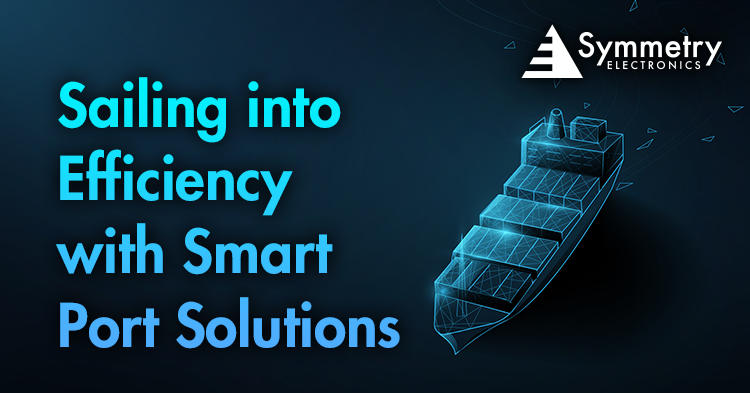Sailing into Efficiency with Smart Port Solutions

Many of us are familiar with the old boating adage, "Red in the morning, sailors take warning," a cautionary phrase echoing through generations of seafarers. However, what if sailors can now throw caution to the wind with the onset of smart technology adoption in the shipping industry? Smart ports are revolutionizing the way the shipping industry navigates efficiency and streamlines operations.
The Shipping Industry’s Role in the Global Supply Chain
In an era marked by the convenience of 2-day Amazon delivery, many of us forget that much of our goods still make their way to us by train, plane, truck, ship, or all of the above. Supply and Demand Chain Executive reports that 90% of world trade is carried by merchant fleets, comprising over 50,000 ships and worth approximately $1.8 trillion. The merchant fleet transports an estimated 11 billion tons of goods annually.
However, recent events have reminded the public that the shipping industry is alive… and perhaps not so well. Situations like the cargo ship that collapsed the Francis Scott Key Bridge or the container ship that blocked the Suez Canal for 6 days in March 2021 shed light on how much maritime miscalculations can impact world trade.
Even with the Suez Canal responsible for 12% of global supply transit, not much is being done to address the variety of challenges that pose unique hurdles to daily operation and long-term sustainability in the shipping industry.
Top 9 Challenges Facing the Shipping Industry
- New Environmental Regulations:
- Rising concerns about air and water pollution, greenhouse gas emissions, and invasive species.
- Introduction of stringent regulations by governments and international bodies.
- Industry response involves significant investments in new technologies, alternative fuels, and supply chain restructuring.
- Security Risks:
- Threats such as piracy, terrorism, and cyber-attacks.
- Piracy disrupts operations and compromises crew safety, especially in high-risk regions.
- Countermeasures include hiring armed guards, deploying security personnel, and integrating technology like drones and surveillance systems.
- Lack of Employees:
- Aging workforce nearing retirement.
- Diminished interest among younger generations in shipping careers.
- Impact of the COVID-19 pandemic.
- Consequences include increased competition for skilled workers, resulting in safety risks, shipping delays, and higher expenses.
- Cost Increases:
- Increasing fuel prices and labor expenses.
- Compliance costs for environmental and safety regulations.
- Strategies to combat rising costs include employing fuel-efficient vessels, adopting alternative energy sources, and refining supply chain operations.
- Extensive Manual Entries:
- Copious paperwork and manual data input.
- Time-consuming, error-prone, and expensive.
- Pivot towards digitalization and automation, embracing electronic documentation and platforms, and exploring technologies like blockchain and artificial intelligence.
- Data Accuracy Dilemma:
- Manual data entry challenges leading to errors.
- Shift towards digital solutions for enhanced accuracy and efficiency.
- Embrace of electronic documentation, IoT sensors, GPS, blockchain, and AI for improved data analysis and security.
- Uncertainty:
- Influenced by geopolitical shifts, economic fluctuations, and natural disasters.
- Industry reliance on digital technologies and data analytics for real-time coordination and collaboration.
- Fostering a culture of collaboration, setting universal standards, and strategic partnerships are essential.
- Coordination Challenges:
- Complexities in coordinating shipping operations among various stakeholders.
- Risks include clashing schedules, erratic cargo movements, and supply chain disruptions.
- Solutions involve digital technologies, data analytics, collaborative business frameworks like blockchain, and fostering a culture of collaboration.
- Real-Time Tracking Conundrum:
- Absence of real-time tracking impacting operational efficiency.
- Adoption of IoT sensors, GPS, and blockchain for real-time shipment tracking.
- Challenges include substantial investments, managing data effectively, and fostering collaboration among industry players.
What is a Smart Port?
Despite the dynamic challenges the shipping industry is facing, success can be achieved through innovation, digitalization, and collaboration. Imagine a world where ports are not just points on a map but intelligent hubs that orchestrate a seamless symphony of operations. Smart Port Solutions serve as the navigational compass for this vision, integrating advanced technologies to optimize processes, reduce delays, and enhance overall efficiency.
Smart Port Technologies
A smart port is a technologically advanced and interconnected port that leverages digital technologies and data-driven solutions to enhance efficiency, safety, and sustainability in maritime operations. Smart ports integrate a variety of technologies, including the Internet of Things (IoT), sensors, automation, data analytics, and communication networks, to streamline and optimize various port processes.
Key features and components of a smart port may include:
- Automation and Robotics: Smart ports often deploy automated systems and robotics for tasks such as cargo handling, container movement, and maintenance operations. This reduces dependency on manual labor, improves precision, and enhances overall efficiency.
- Real-time Monitoring and Analytics: Sensors and monitoring devices are employed to collect real-time data on various aspects of port operations, including vessel movements, cargo status, and environmental conditions. Advanced analytics are then applied to derive insights, optimize processes, and make data-driven decisions.
- Digital Platforms and Connectivity: Smart ports rely on digital platforms that facilitate seamless communication and collaboration among stakeholders, including shipping companies, port authorities, customs officials, and logistics providers. Enhanced connectivity ensures smoother information exchange and coordination.
- Intelligent Traffic Management: Smart ports use smart traffic management systems to optimize the movement of vessels within the port area. This includes efficient berthing, navigation assistance, and minimizing congestion to improve overall port throughput.
- Environmental Monitoring and Sustainability Initiatives: With a growing emphasis on environmental sustainability, smart ports often incorporate systems for monitoring air and water quality, as well as emissions. These ports may also implement green technologies, alternative energy sources, and eco-friendly practices to reduce their ecological footprint.
- Security and Safety Systems: Smart ports prioritize security through the deployment of advanced surveillance systems, access control mechanisms, and cybersecurity measures. Additionally, safety protocols are enhanced to prevent accidents and ensure the well-being of port workers and visitors.
- Predictive Maintenance: Utilizing IoT sensors, smart ports implement predictive maintenance strategies to monitor the health of equipment and infrastructure. This helps in identifying potential issues before they escalate, reducing downtime and optimizing maintenance schedules.
- Smart Grids for Energy Management: Some smart ports incorporate smart grid technologies to efficiently manage energy consumption. This includes optimizing lighting, power distribution, and other energy-intensive operations within the port.
Enhancing Traditional Port Operation with Solutions Available at Symmetry Electronics
The overarching goal of a smart port is to create a connected and intelligent ecosystem that enhances overall efficiency, reduces operational costs, and contributes to sustainable and resilient port operations in the face of evolving challenges in the maritime industry. Innovations like cargo ship asset tracking solutions can be utilized to eliminate downtime. Luckily, Symmetry Electronics provides developers with the advanced technologies required to design state-of-the-art devices that address the headwinds facing the shipping industry.
As the next generation of their xE310 product family, Telit’s ME310M1 is a Cat M1 and NB2 module that enables secure, massive, and power-efficient IoT designs. Its ultra-low power consumption, Power Saving Mode (PSM), extended Discontinuous Reception (eDRX), and enhanced coverage quality make it an ideal solution for maritime asset tracking as these features significantly increase the longevity of battery-operated devices – crucial for the remote, rugged environments of shipping applications.

Semtech's LR1121 is an advanced ultra-low power LoRa® transceiver offering multi-band communication including LoRa and LR-FHSS over various frequency bands, along with satellite S-Band connectivity. It adheres to LoRaWAN® specification standards while offering flexibility for customization to suit different application needs and proprietary protocols, making it an ideal solution for cargo ship asset tracking due to its robust communication capabilities and adaptability to varying environments and protocols.
Also from Semtech, the LR1110 integrates multiple functionalities including LoRa® transceiver, FHSS modulator, and Wi-Fi MAC address scanner for asset management. Leveraging Semtech's LoRa Cloud Geolocation, it reduces power consumption by determining asset location through a Cloud-based solver. This solution is well-suited for the shipping industry's asset management needs due to its efficient power usage and comprehensive tracking capabilities.
The u-blox MAX-M10M module utilizes u-blox M10 GNSS platform, supporting concurrent reception of four GNSS signals for optimal position availability, particularly in challenging environments like urban canyons. Featuring u-blox Super-S technology, it offers high RF sensitivity and enhanced dynamic position accuracy, making it suitable for cargo ship asset monitoring. Additionally, its cost and power optimization, along with backward compatibility, streamline design efforts and reduce upgrade costs, enhancing its suitability for asset monitoring applications.



